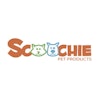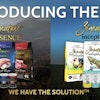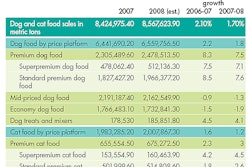
It used to be enough that petfoods met pets' tastes and their nutritional needs. But with the significant evolution of the global petfood market that has been accompanied by a strong premiumization trend, foods that are going to fly off shelves also have to answer to the pet owner's demand for the best quality, period. Petfood companies are now looking at how dogs respond genetically to a particular diet and how cats respond to different moisture content in kibble. Petfood manufacturers should spend a considerable amount of time conducting controlled feeding studies to determine the right combination of ingredients and processing techniques to produce a nutritious, palatable food.
A compelling crunch
According to SPF, making a petfood downright delicious for dogs or cats is not only its core business, but a combination of varied expertise it has developed over time. SPF, according to the company, has always presented palatability performance as a result of a global approach, taking into account the palatability enhancer and its application for dry kibble, wet product or various forms of treats. This palatability system also includes studying the specific petfood formula and its manufacturing process, as these factors affect taste, texture and shape of the end product.
Today, SPF innovation is driven by fundamental research. Take for example, the identification of specific aroma molecules, 10 years ago, that were particularly appreciated by dogs or cats. This discovery threw light on the importance of raw materials and of the very processes for palatability performance. Using this breakthrough as a starting platform, SPF continues to develop new technologies that support the creation of high level palatability enhancers with specific targeted compounds. For the future, understanding the physiology and mechanisms of pet perceptions and feeding behaviors are the key concepts to the science of palatability, as SPF sees it.
SPF chemists, flavorists, ethologists and food engineers are supported by the application team who are completely knowledgeable of petfood processes and are able to explain all the interactions that can occur in a sophisticated product like kibble. Through the Aplicalis service, offered exclusively by SPF, this knowledge directly benefits the customer, who now has a team of experts and their advice and ideas to optimize petfood formulation.
Focus on function
Functional palatants are flavors for petfood and treats that add additional nutritional value to the diets and can positively affect the health of companion animals, according to Dr. Chris Nelson of Kemin Industries Inc.
One class of functional ingredient is antioxidants. The oxidation of petfood will create rancidity and decrease the quality and nutritional value of the food. Antioxidants are molecules that sacrifice themselves rather than allow oxidation of the petfood. The addition of antioxidants to components of the food, including the palatant, can positively and impressively impact the palatability of the food, according to Kemin.
Another example of a functional ingredient that can positively impact the health of cats and dogs, according to Kemin, is zinc propionate. Zinc is an important trace mineral in companion animals, affecting skin, immune and dental health. The bioavailability of organic zinc as measured by plasma levels after zinc propionate supplementation is considerably increased when compared to that of inorganic zinc.
Future on our forks?
Professor Gary Pickering, the chair and professor of biological sciences and wine science at Brock University in St. Catharines, Ontario, Canada, claims that he has discovered that human testers rated cat food successfully, ultimately benefitting cat food consumers. In a recent Journal of Animal Physiology and Animal Nutrition paper, Dr. Pickering explains the potential value of having people rate cat foods. For example, he believes it might enable manufacturers to understand why a cat favors certain foods. While manufacturers conduct trials to see what felines prefer, it's difficult to know exactly which flavors or textures the cats are responding to, he explains.
"Cats aren't very good at vocalizing what they like or don't like about cat foods," said Dr. Pickering, who conducted the study in Australia before coming to Brock University. "The idea was that humans can quite clearly verbalize what it is. Humans can also rate the intensity of different characteristics in a particular food or beverage." Dr. Pickering says the value of his recent work could lie in taking the results of the human testing and comparing them to results of cat testing on the same products. It might offer a shortcut for researchers, he says.
Testers rated the foods on 18 flavor attributes, including tuna, prawn, chicken, caramel, cereal, soy, burnt flavors, bitter and offaly. They also evaluated textures, such as grittiness and chewiness.
In response, Dr. Timothy J. Bowser, co-director of the Oklahoma State University Center for Pet and Animal Food Palatability Studies, says that while humans can play an important role in cat food palatability development, the cats themselves are essential to the process. "Human input is sought first to evaluate odor, appearance, value and feel," says Dr. Bowser. "But we haven't ever asked anyone to taste cat food or any other petfood. The pets tell us everything we need to know through preference testing methods that are almost identical to the methods used on human foods. Getting the opinion directly from the pet is much more accurate than working indirectly through humans, in my opinion."






.png?auto=format%2Ccompress&fit=crop&h=167&q=70&w=250)










